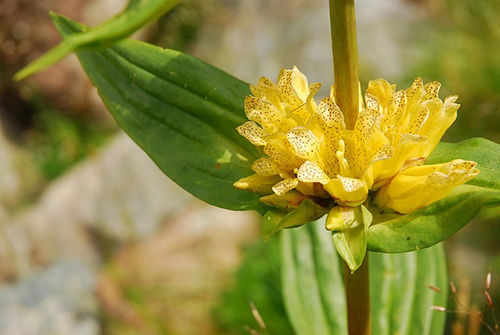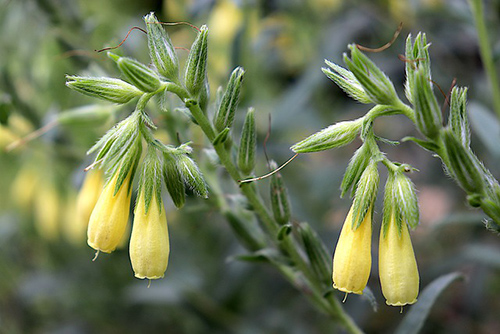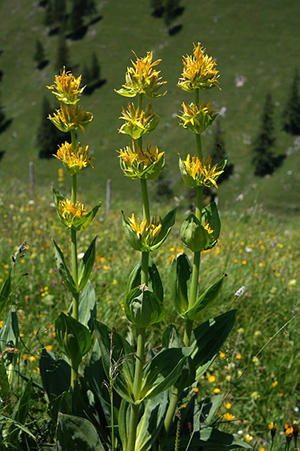The gentian plant grows so slowly that it takes ten years to bloom and can live up to fifty years. This behavior could be an example for people who are fond of nature. Some greedy plant-gatherers have brought the gentian to the edge of extinction. It is a pity when its colossal root, weighing up to six kg, has been systematically gathered to give its aroma to alcoholic beverages.
- Expertly extracted for digestive system support.
- Prepared from the certified organic rhizome and root of Gentiana lutea plants.
- Rapidly absorbed liquid extract.
- Gluten-free and non-GMO.
- Herb potency assured through High Performance Thin Layer Chromatography (HPTLC) analysis.
The great Greek physician, pharmacologist, botanist, and author Pedanius Dioscorides wrote in his De Materia Medica: “The root of gentian, when drunk with water, helps people suffering from liver and stomach disorders.” Some twenty centuries later, the observation of that Greek scholar is still valid, and gentian is one of the most appreciated appetizers and digestive plants.

Scientific Facts
- Other names: Bitterwort.
- French: Gentiane.
- Spanish: Genciana.
- Environment: The gentian plant grows in meadows and sunny slopes in mountainous areas of Central and Southern Europe, preferably in calcareous soils. It is also cultivated in America.
- Description: This vigorous plant of the Gentianaceae family grows from 60 to 100 cm high. It has a smooth, upright stem from which large, oval-shaped flowers grow opposite one another. The flowers are bright yellow and grow in clusters.
- Parts of the plant used medicinally: The root.
Healing Properties and Warnings

The root of this plant contains diverse bitter components, among which the most outstanding are gentiopicrin and amarogentin. The latter is the bitterest substance known. When dissolving part of amarogentin in fifty million parts of dissolvent, its bitter flavor is still noticeable. Moreover, it contains various sugars, tannin, and pectin. Its properties are as follows:

- Stomachic invigorator: The bitter components of the root excite the secretion of all digestive glands, including saliva glands. Thus, they increase appetite and promote digestion. The root is especially recommended for chronic gastritis with a lack of gastric juice, ptosis, gastric atony, indigestion, vomiting, lack of appetite, and recovery from feverish diseases. According to Dr. Leclerc, “Invigorator but not an irritant.”
- Choleretic and cholagogue: It stimulates bile secretion in the liver and empties into the duodenum. It is recommended for liver congestion and biliary dysfunction.
- Febrifuge: Gentian does not have strong febrifuge properties; however, it is especially effective for malaria. It has been proven that gentian can destroy the protozoa that cause malaria and attack red blood corpuscles. It can be used in association with quinine and is particularly recommended for quinine-resistant malaria.
- Immunostimulant: It stimulates the body’s defenses. Gentian root increases white blood corpuscle (leukocyte) production; thus, positive action in cases of immune system depression (lack of infectious resistance) is probable.
WARNING! People suffering from an active gastroduodenal ulcer should abstain from using gentian since an increase in gastric juice secretion will worsen the illness. It should also be avoided during breastfeeding because the bitter components it contains pass to the milk, and although they are not toxic, children on a milk diet will refuse to take it.
WARNING! The gentian plant must not be mistaken for white hellebore (Veratrum album L.), a toxic plant that grows near gentian. The difference is that the former has alternate leaves (which grow singly from the stem), hairy on the underside, and white flowers with a pretty unpleasant smell.
The gentian plant is mainly a remedy for the stomach and liver. It is a bitter tonic herb that hastens intestinal action and affects slow digestion. It increases digestion, improves circulation, and improves appetite. It treats gout, colds, slow urination, female problems, and pancreatitis.
NOTE: Because it is bitter, combine it with aromatic herbs, such as spearmint, wood betony, sassafras, peppermint, and ginger.
Gentian Liquor: We advise against using alcoholic preparations or liquor from gentian since the harmful effects of alcohol counteract the plant’s beneficial properties.
How to use Gentian
- Cold extract: Put a piece of gentian root (the size of a hazelnut: around 10g) in a liter of cold water. Steep for four or five hours. Drink three cups daily before meals. Some anise seeds can be added during the process to reduce their intensely bitter flavor; however, sweetening is advised against it.
- Decoction
- Powder or dry extract
Decoction: Simmer for five to fifteen minutes and take ¼ to one teaspoon three times daily to ½ to one cup daily. Tincture: Take ½ to two teaspoons three times daily. Fluid Extract: Take ¼ to ½ teaspoon three times daily. Powder: Take two to four #0 capsules (10 to 30 grains) thrice daily.
REFERENCES
- George D. Pamplona-Roger, M.D. “Encyclopedia of Medicinal Plants.” George D. Pamplona-Roger, M.D. Encyclopedia of Medicinal Plants. Ed. Francesc X. Gelabert. vols. 2 San Fernando de Henares: Editorial Safeliz, 2000. 452,453. Print. [Gentian plant]
- Vance Ferrell Harold M. Cherne, M.D. The Natural Remedies Encyclopedia [Book]. – Altamont, TN: Harvestime Books, 2010. – Vol. Seventh Edition: 7: pp. 159, 160.
Last update on 2025-06-15 / Affiliate links / Images from Amazon Product Advertising API





